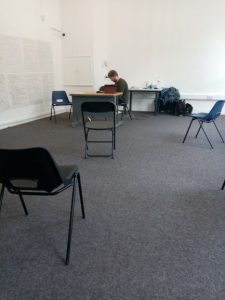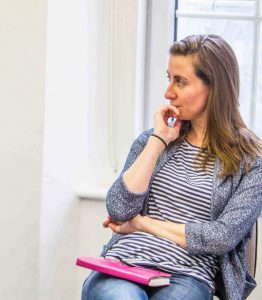I used the first stage of the Belltable:Connect 10 Bursary to research into prosthetics and orthotics and how they can be used to tell the story and talk about the identity of the person who wears them. My play was going to be set in a prosthetic maker’s workshop, he/she was going to be the storyteller of the play and as he/she made the prosthetics they would tell the stories of those who have worn them. However this has changed, yes there will be prosthetics makers in each story but it is the person who wears them that tell their own story and finally in the modern story, the wearer and the prosthetic maker are one and the same.
The Other Limb will be told through storytelling, animation, puppetry and object theatre. It will look at loss, the rise of disability activism, societal historic view on disability, the history of prosthetics, while talking ableist views of the body.
I have spent 9 days over the last two months researching, writing, making shadows and discussing with fellow puppeteer Nikki Charlesworth and Mentor Gavin Kostick. I have been historically charting prosthetics and disability activism in the 20th and 21st century. Through conversations with Nikki what became apparent was although we have different disabilities we have shared experiences with each other and with the past, with our disability culture.
I have a loose treatment, see below, and a lot more research to do but my play has changed and grown, it has ignited a spark and led me down the road of disability activism. Here is a screen shot of my Pinterest board which I started at Stage 1 and which has grown as my ideas have in stage 2. 
Mentorship
Gavin Kostick was my mentor and we checked in every few weeks, he asked me the great questions, we discussed all the topics arising and Gavin gave me tasks to bring on my research as well as plays to read.
We discussed everything from Tony Iommi Black Sabbath guitarist who has a disability and the song Iron Man (see lyrics below), to language around disability and Pelops Ivory shoulder. We discussed the lay out of the play and when I was stuck as I was unsure as to whether to use puppetry or actors, Gavin got me to do a breathing exercise to empty out sounds and thoughts and then trying to visualise and think through thoughts. It really worked I opened my eyes and knew that I wanted human storytellers and not puppet ones.
‘I am iron man
Has he lost his mind?
Can he see or is he blind?
Can he walk at all
Or if he moves will he fall?
Is he alive or dead?
Has he thoughts within his head?
We’ll just pass him there
Why should we even care.’
I sent through Gavin a loose treatment, he suggested a different structure which worked far better. His last task was to give me a flowchart to do (see below).
Meetings with Nikki
Over the month of October I met with Nikki Charlesworth twice, we talked about our experiences growing up with a disability, our work as puppeteers creating work about our identities, our shared experiences, other work that has inspired us as artists and she helped me work through my ideas. One idea that really emerged from our first meeting was the idea of the characters taking over the role as storyteller and removing or putting on prosthetics to tell a story of their character,s life. In the second meeting we discussed activism and Nikki described her father’s experiences of being at a protest in the 80s, about accessibility to public transport. Hundreds of people who use wheelchairs, toppled their chairs on the road in front of a bus and sat on the road protesting the buses not being accessible. These conversations made me realise that the modern section was around three people discussing disability issues and through doing that, act out historic and current stories like mini plays within a play.
Very loose treatment : The Other Limb
Modern Day
Three performers arrive on stage, they are carrying protest signs but they are relaxed on their shoulder or their lap, they are also carrying prosthetics, orthotics and costumes in boxes, they are on their way to a protest. (they are similar to Shakespearean players carrying baskets of different costumes)
They are discussing what has brought them there what has inspired them to be a disability activist. There are other boxes on the stage also filled with prosthetics and orthotics and there is a projection screen behind them. They discuss putting on theatre and film, about disability representation.
They start to talk about those who have protested before them.
1st play within the play
One of the two puppeteers comes forward and picks up the second mask, they take off an orthotic and hand it to another performer who puppeteers it, she sits down in a box stage left she is now the storyteller.
The prosthetics also have the mask showing that they belong to the same character?
This section follows the start and development of the disability human rights in the mid 20th century following the ww2. This story is told from a women activists point of view.
At the end of her story, the storyteller talks about the protestors who had been injured in the war, she starts to talk about what happened to people with a disability in WW2 who were lined up to be killed, as she does she joins the other performers emptying all the boxes of prosthetics creating a pyre of prosthetics centre stage.
A pile of prosthetics are centre stage. Three prosthetics and a mask lies on the front of stage. The shadows of people in lines giving up their prosthetic’s/orthotics to soldiers and them being thrown in a pile and being pushed into a box one by one.
2nd play within a play
This section will look at 1914 up to the 1940s life and the views around disability.
Story teller 2 walks on stage like the line and adds his prosthetic to the pile, we then see the shadows going in reverse. The person comes backwards puts on their prosthetic. The prosthetics are dispersed around the room creating a prosthetic makers workshop. The man sits stage left. He is the 2nd story teller.
We show some way they have gone back into the past and are being fitted for their prosthetic by Mr. Gillingham’s in England (called the Geppetto of prostatic devices), we follow the prosthetic from prosthetic maker to pier.
https://mashable.com/2015/07/26/early-prosthesis/?europe=true
We see a soldier going off to war, losing their limb, being fitted for a prostethic,
then during the second war ending up at a concentration camp.
The third of the performers come forward, she looks at him then down at the pyre, she pulls out a beautiful modern prosthetic, she sits on the stage left box and takes her other off and puts it on, she reaches down and puts on the 3rd of 4 masks. While she is doing this the other two performers put the prosthetics back in boxes.
Third play in play: 21st century
The 3rd storyteller : This piece is more abstract
This character is made up of Nikki and my testimonies, my partner Ivan who makes prosthetics and inspired by artist with disabilities work like Lisa Buffano.
The third character is the prosthetic/orthotic maker, they create their own prosthetic’s/orthotics. They use them to create art, perform, talk about their identity. Reclaim the negative word of the past. A celebration their disability to reflect on the history to see how that has effected the now. To show where they need to go.
At the end the performer puts down the mask picking up the forth mask and passing it to an audience member.
Modern Day
All three of them lift up their signs handing a sign to the person with the mask and other members of the audience. The shout’ nothing about us without us’ over and over encouraging the audience to join in as they lead them out of the theatre in a protest.
The End
Research for 1st play within the play
https://www.leapinfo.org/advocacy/history-of-disability-rights/1940s
https://www.nps.gov/articles/disabilityhistoryrightsmovement.htm
Prosthetics/orthotics protesting.
The medical model and social model of disability.
There will be a prosthetic maker but they will not be the main character.
‘Not until the early 1960s did the National Academy of Sciences National Research Council begin to promote multidisciplinary scientific research efforts into human locomotion, biomechanics, and the development of new materials and devices (7). Innovations in prosthetic and orthotic designs were influenced by the adaptation of industrial techniques for vacuum forming sheet plastics. By the 1980s the continuing introduction of new materials and methods spurred the profession of prosthetics and orthotics to rapidly evolve as a changing discipline. In an attempt to keep its professionals updated, the 1990s saw significant advancement in the development of educational programs with the establishment of national education accreditation through a subsection of the American Medical Association.’
Possible storyteller: “the grandmother of the Independent Living Movement” Gini Laurie, who devoted her life to volunteering for polio survivors from 1958 until her death”
Research 2nd play within a play
‘Around two million came home with some level of disability: over 40,000 were amputees; some had facial disfigurement or had been blinded. Others suffered from deafness, tuberculosis or lung damage caused by poison gas.’
Note: Keiser Willem had a brachial plexus like mine, he was treated with electric shock and other treatments, his arm was hidden in photos and his mom didn’t want anything to do with him, they thought he was deformed and so treated him badly, this led to him growing up being angry and resentful. (they talk about his disability leading to him being this way but it was the way he was treated)
More links to help with my research
https://www.nytimes.com/2020/07/23/obituaries/cheryl-marie-wade-overlooked.html














